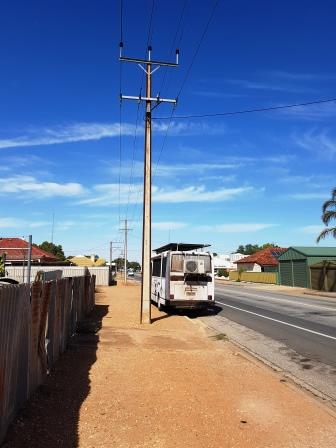Maximising solar harvest
No matter what type of battery you're using, you need enough solar to make up for the amount of power you're taking out of your battery, or some other method to replace what you've used. If you have lead acid batteries, you actually need to replace 125% of what you've used in order to get back to 100% state of charge.
Follow the sun with portable panels
If your panels are tilted toward the sun, you will get a better harvest.
If you track the sun, you will almost double your harvest. This is where portable panels have an advantage, but only if you take the time to move them periodically throughout the day. The more you move them, the greater your harvest will be.
If you only have portable panels, you have the added advantage that you can park your RV in the shade and still collect solar power. Just make sure you use good super-sized cabling because you'll invariably have a long distance for the power to travel to get back to your battery.
Keep them clean
It's amazing how much dirt gathers on solar panels, but I'll be the first to admit that cleaning them is not fun.
You might want to consider using a cut & polish compound on them once in a while. Then the next few cleans can be just a decent squirt with a hose. Just like the older cars, polished paint work is easier to keep clean.
Bigger is not always better
Lots of smaller solar panels instead of several large panels is a better configuration when near shadows or when birds drop their bombs. You only need to block 1% of any of the photovoltaic cells on a solar panel for you to lose all of the output from that panel, or section of that panel when bypass diodes are used.
If you're short on roof space, smaller panels (we use 60W panels a lot) can fit between air conditioner units, vents and TV aerials. The shadow might be on the panel in the morning, but by the afternoon, those panels will be in full sun while the ones on the other side of the air conditioner, vent etc, will be in the shade.

Curved frame on Avida Esperance with 17 x 60W panels
Bonus solar
You know those days where there's a lot of cloud about, but somehow also a lot of glare outside - enough to make your eyes hurt? Those are actually very good solar days.
Parking near water, salt flats or snow will also give you bonus bounce-back solar.
Watch out for shadows
 In late February 2019 we were stopped at Crystal Brook on a glorious sunny day. When we arrived at about 8am, we were bringing in 63 amps from 1.6kW of solar on the roof of our Hino.
In late February 2019 we were stopped at Crystal Brook on a glorious sunny day. When we arrived at about 8am, we were bringing in 63 amps from 1.6kW of solar on the roof of our Hino.
By 10:34am, the shadow of the power pole had moved over the roof at such an angle that every panel had some shadow over it.
At that point we were bringing in just 3 amps of solar! From one lousy power line!
It only takes one photovoltaic cell to have any shadow over it, and the loss of that cell will drop the voltage of the whole solar panel to a point where the voltage is no longer high enough to push any current to your battery.
If the shadow is across the panel - and the shadow need only be as wide as a piece of string - you will lose all the output from that panel. If the shadow is down the panel, you may only lose half the output, but note the point above about voltage drop.
Get the wind beneath your solar panels
Given that heat has a fairly significant effect on your solar harvest, an important part of mitigating the heat of your panels is to try and disperse it. Face it, other than sitting in the shade, you can't really avoid it!
So the typical and easiest way to disperse the heat of a solar panel is by air cooling. A panel should never be attached directly to your RV roof because the four edges of the frame make a quite effective heat trap.
At T1 Lithium, we use aluminium angle, usually on the two longer sides of a panel, so that air can flow under the panel, preferably from front to back, as this is the natural flow of air when you're driving.

For front panels that face the full blast from forward motion and oncoming traffic, we use a piece of aluminium on the forward edge that we put several large holes in. This gives you the cooling but not the massive air pressure that can lose you a panel whilst travelling.
Heat and semi-flexible panels
If you have semi-flexible panels and they're stuck directly to your RV roof, the heat is going to kill them. Part of the problem is that there is no air movement beneath a panel that's stuck directly to an RV roof.
Another part of the problem is that semi-flexible panels are quite delicate. If you stick them to anything, they are likely to suffer damage because the rate of expansion and contraction of whatever you stick them to is unlikely to be the same as the rate of expansion and contraction of the panel itself.

Our recommended cable sizes from your panels, to extending that cabling to a junction box and from the junction box to your solar controller, with a look at the vagaries of MC4 connections and the need for circuit breakers so you can isolate your solar input.
We've put together a simple formula based on the advertised capacity of a solar panel, and other factors such as geography and time of year, so that you can work out how many amps your solar should be harvesting to charge your battery.
You could test each solar panel by measuring the voltage at the back of each panel, but this is tricky. We go over a fairly easy way to test each individual solar panel and signs of a damaged panel.